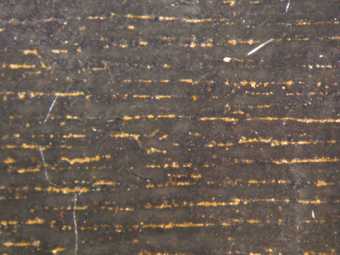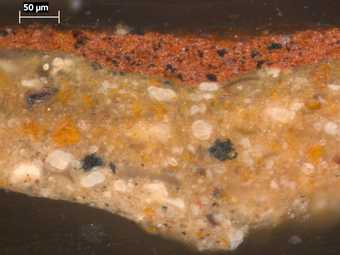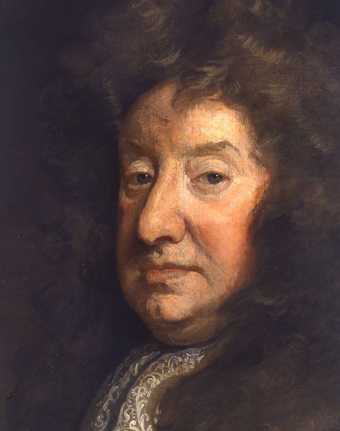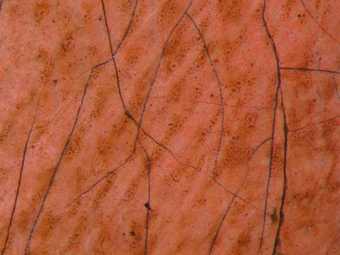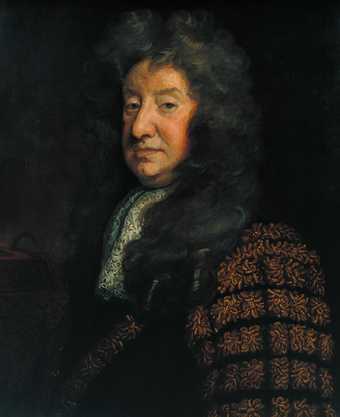
Fig.1
Sir Godfrey Kneller 1646−1723
The First Marquess of Tweeddale
1695
Oil paint on canvas
752 x 638 mm
N03272
This painting is in oil on canvas measuring 752 x 638 mm (fig.1). The linen is plain woven with 14 vertical threads and 12 horizontal per square centimetre. A great many slubs in the horizontal direction give a very variable thread thickness. There is cusping at the left and right edges of the painting but none at the top and bottom (fig.2).1 As the original tacking edges are no longer present, we cannot tell whether the painting has been trimmed in size but if it had been it seems unlikely that the amount of loss was great. It is possible that this piece of canvas was cut from a long, narrow, pre-primed roll, which would have been kept taut along its long edges for priming, hence the cusping there.
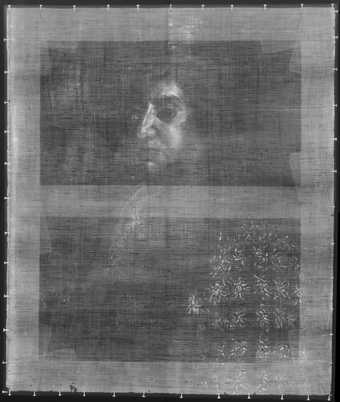
Fig.2
X-radiograph of The First Marquess of Tweeddale
The ground is greyish tan colour and its surface has uniform striations all over; they are visible under magnification as horizontal ridges approximately 0.5 mm apart (fig.3). This ridged surface was produced by the tool with which the ground was applied. Inspection of the cross-sections in ultraviolet light suggests that there were three applications of ground (figs.4 and 5). All three layers are consistent in pigmentation but have slight variations in the particle size of the blacks and in the proportion of yellow ochre, with the uppermost layer containing more yellow and fine black whilst the lowest layer contains less yellow and a large, irregularly shaped black particles. Pigments identified with polarised light microscopy were lead white, chalk, red earth colour, raw sienna earth, black and a trace of vermilion.2
No underdrawing was detectable with infra-red reflectography or with microscopic examination. Like many of Kneller’s ‘Kit-cat’ portraits of this period, this face was accomplished with a spirited, economical technique.3 Starting with thin, reddish brown paint, Kneller would lay in the contours of the face and features. Then, using flesh tones mixed on his palette, he would paint the face with direct, bravura brushwork, leaving the greyish tan coloured ground visible in many areas to work as a neutral half-tone or half-shadow. This may be seen in figs.6−8. The ground, lightly glazed here and there with brown paint, also forms the mid-tone of the wig. The final paint layer of flesh paint is stiff and textured, though applied quite thinly. The pink flesh tones are fairly simple mixtures of lead white with vermilion, black and earth colours. As visible in fig.8, red lake was used for the deepest shadows. The brown background contains yellow ochre, sienna, black, umber, vermilion, lead white and pipeclay. The yellow highlights on the brocade contain lead white, lead tin yellow, earth colours, chalk, ground glass and pipeclay.
Unusually in a seventeenth-century picture the paint has developed microcissing in the troughs of the brushstrokes in the face and also in the black costume (figs.9 and 10). Microcissing is the formation of microscopic craters in the whites and flesh tones, and small islands of paint in the dark areas.4 Lead soap aggregates, probably originating from the ground, are visible at high magnification on the surface of the red areas and in the thinnest passages of black in the robe.5
Since this study was undertaken, the painting has been cleaned and restored.
March 2005

